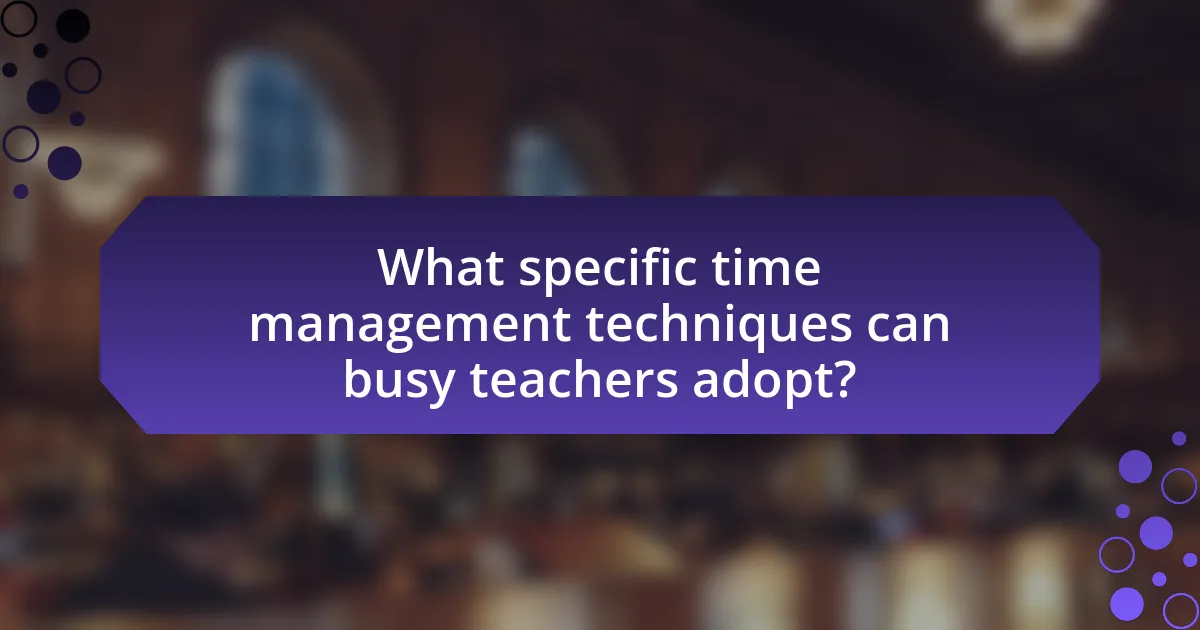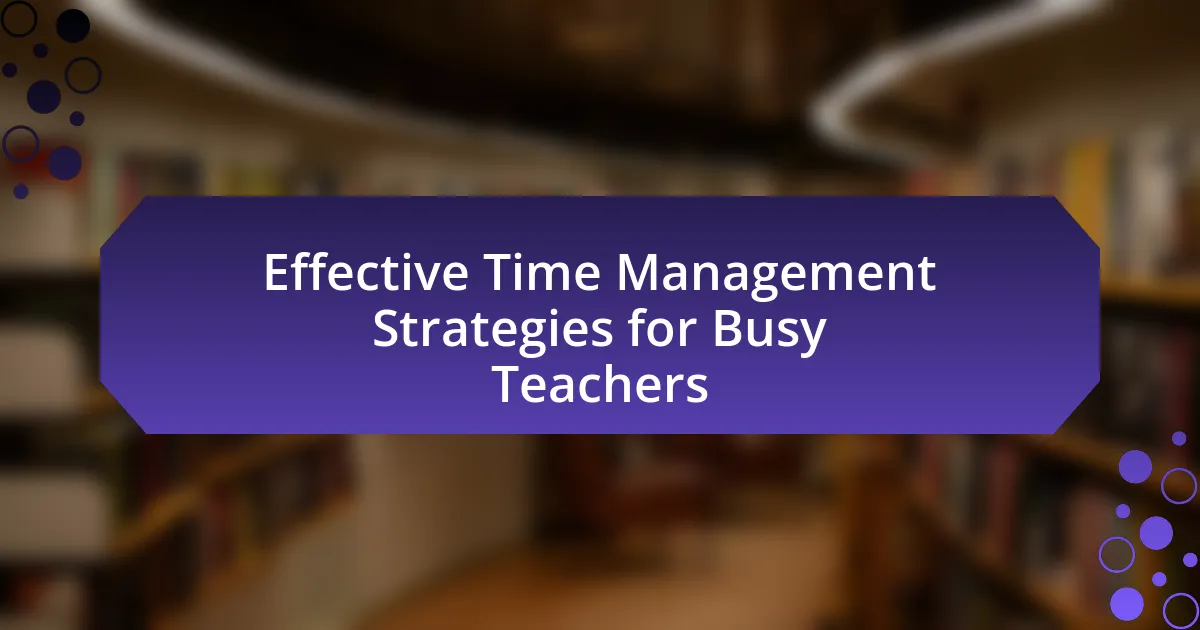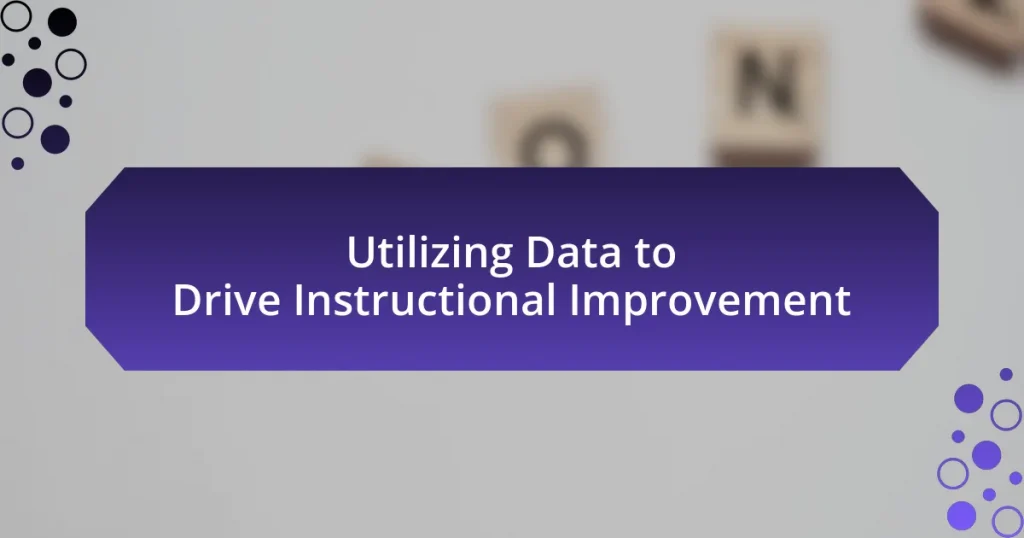The article focuses on effective time management strategies specifically designed for busy teachers. It outlines key techniques such as prioritizing tasks, utilizing planning tools, and setting SMART goals to enhance productivity and reduce stress. The article also addresses common time management challenges teachers face, including excessive administrative tasks and classroom management issues, while emphasizing the importance of self-assessment and structured planning. Additionally, it explores the benefits of digital tools and specific techniques like the Eisenhower Matrix and the Pomodoro Technique, which can significantly improve teachers’ efficiency and job satisfaction.

What are Effective Time Management Strategies for Busy Teachers?
Effective time management strategies for busy teachers include prioritizing tasks, utilizing planning tools, and setting specific goals. Teachers can enhance productivity by categorizing tasks based on urgency and importance, which allows them to focus on high-priority activities first. Implementing digital planners or scheduling apps can streamline lesson planning and grading, making it easier to allocate time effectively. Additionally, setting SMART (Specific, Measurable, Achievable, Relevant, Time-bound) goals helps teachers maintain focus and track progress. Research indicates that teachers who employ structured time management techniques report reduced stress and improved job satisfaction, highlighting the effectiveness of these strategies in educational settings.
How can teachers identify their time management challenges?
Teachers can identify their time management challenges by conducting a self-assessment of their daily activities and responsibilities. This involves tracking how much time is spent on various tasks, such as lesson planning, grading, and administrative duties, to pinpoint areas where time is wasted or misallocated. Research indicates that teachers often underestimate the time required for specific tasks, leading to ineffective scheduling and increased stress. By utilizing tools like time logs or reflective journals, educators can gain insights into their routines and identify specific bottlenecks or distractions that hinder productivity.
What common obstacles do busy teachers face in managing their time?
Busy teachers commonly face obstacles such as excessive administrative tasks, lack of planning time, and classroom management challenges in managing their time. Administrative tasks, including grading and paperwork, consume significant hours, limiting time available for lesson planning and student interaction. Additionally, many teachers report insufficient time during the school day to prepare lessons or collaborate with colleagues, which hampers their effectiveness. Classroom management issues, such as addressing diverse student needs and behavioral problems, further distract from instructional time, making it difficult for teachers to adhere to their schedules. These factors collectively contribute to a chaotic work environment, leading to stress and reduced productivity.
How can self-assessment help teachers improve their time management?
Self-assessment can help teachers improve their time management by enabling them to identify their strengths and weaknesses in planning and executing tasks. Through self-assessment, teachers can reflect on how they allocate their time, recognize patterns of inefficiency, and set specific goals for improvement. Research indicates that reflective practices, such as self-assessment, lead to enhanced self-regulation and better organizational skills, which are crucial for effective time management. For instance, a study published in the “Journal of Educational Psychology” found that teachers who engaged in self-reflection reported increased productivity and more effective use of instructional time.
Why is time management crucial for teachers?
Time management is crucial for teachers because it directly impacts their ability to deliver effective instruction and maintain a productive classroom environment. Effective time management allows teachers to allocate sufficient time for lesson planning, grading, and student engagement, which are essential for enhancing student learning outcomes. Research indicates that teachers who effectively manage their time report higher job satisfaction and lower stress levels, contributing to a more positive educational experience for both themselves and their students.
What impact does effective time management have on teaching quality?
Effective time management significantly enhances teaching quality by allowing educators to allocate sufficient time for lesson planning, student engagement, and assessment. When teachers effectively manage their time, they can create more structured and focused learning environments, which leads to improved student outcomes. Research indicates that teachers who prioritize time management report higher levels of job satisfaction and effectiveness, as they can better meet curriculum goals and address individual student needs. For instance, a study published in the “Journal of Educational Psychology” found that effective time management practices correlate with increased student achievement and engagement, demonstrating the direct impact on teaching quality.
How does time management influence teacher well-being and job satisfaction?
Time management significantly enhances teacher well-being and job satisfaction by reducing stress and increasing productivity. Effective time management allows teachers to allocate sufficient time for lesson planning, grading, and personal development, which leads to a more organized and less chaotic work environment. Research indicates that teachers who employ time management strategies report higher levels of job satisfaction and lower levels of burnout, as they feel more in control of their workload. For instance, a study published in the “Journal of Educational Psychology” found that teachers who effectively manage their time experience a 20% increase in job satisfaction compared to those who do not prioritize time management. This correlation underscores the importance of time management in fostering a positive teaching experience and overall well-being.
What are the key principles of effective time management for teachers?
The key principles of effective time management for teachers include prioritization, planning, organization, and delegation. Prioritization involves identifying the most important tasks that align with educational goals, ensuring that critical responsibilities are addressed first. Planning requires creating a structured schedule that allocates specific time blocks for teaching, grading, and administrative duties, which enhances productivity. Organization entails maintaining a systematic approach to resources and materials, allowing for quick access and efficient use of time. Delegation involves assigning appropriate tasks to students or colleagues, fostering collaboration and reducing individual workload. These principles are supported by research indicating that effective time management can lead to improved teacher performance and student outcomes.
How can prioritization enhance a teacher’s productivity?
Prioritization enhances a teacher’s productivity by allowing them to focus on the most critical tasks that directly impact student learning and classroom management. By identifying and addressing high-priority activities, such as lesson planning and student assessments, teachers can allocate their time and resources more effectively. Research indicates that teachers who prioritize their tasks report higher levels of job satisfaction and improved student outcomes, as they can dedicate more attention to essential instructional strategies and individualized student support. This structured approach not only streamlines their workload but also fosters a more organized and efficient teaching environment.
What role does planning play in effective time management?
Planning is essential for effective time management as it allows individuals to prioritize tasks, allocate resources efficiently, and set clear goals. By creating a structured plan, teachers can identify their most important responsibilities and deadlines, which helps in minimizing procrastination and distractions. Research indicates that individuals who engage in regular planning are more likely to achieve their objectives and manage their time effectively, as evidenced by a study published in the Journal of Educational Psychology, which found that structured planning significantly improved academic performance among educators.
How can teachers implement time management strategies in their daily routines?
Teachers can implement time management strategies in their daily routines by prioritizing tasks, utilizing planning tools, and setting specific time limits for activities. Prioritizing tasks involves identifying the most critical responsibilities, such as lesson planning and grading, and addressing them first to ensure essential duties are completed. Utilizing planning tools, such as digital calendars or to-do lists, helps teachers organize their schedules effectively, allowing them to allocate time for each task systematically. Setting specific time limits for activities, such as dedicating 30 minutes for grading or 15 minutes for email responses, encourages focused work and minimizes distractions. Research indicates that structured time management can enhance productivity and reduce stress among educators, making these strategies vital for effective teaching.
What tools and resources can assist teachers in managing their time effectively?
Teachers can effectively manage their time using tools such as digital planners, task management apps, and scheduling software. Digital planners like Google Calendar allow teachers to organize their schedules, set reminders, and share events with students and parents, enhancing communication and accountability. Task management apps such as Trello or Asana enable teachers to prioritize tasks, track progress, and collaborate with colleagues on projects, which streamlines workflow. Scheduling software like Doodle can simplify the process of finding suitable meeting times, reducing back-and-forth communication. These tools collectively enhance efficiency, allowing teachers to focus more on instruction and less on administrative tasks.

What specific time management techniques can busy teachers adopt?
Busy teachers can adopt specific time management techniques such as prioritizing tasks using the Eisenhower Matrix, implementing time blocking, and utilizing digital tools for organization. The Eisenhower Matrix helps teachers categorize tasks into four quadrants based on urgency and importance, allowing them to focus on what truly matters. Time blocking involves scheduling specific blocks of time for different activities, which can enhance focus and productivity. Additionally, digital tools like Google Calendar or Trello can streamline task management and communication, making it easier for teachers to stay organized and on track. These techniques are supported by research indicating that structured time management leads to improved efficiency and reduced stress among educators.
How can the Pomodoro Technique benefit teachers?
The Pomodoro Technique can benefit teachers by enhancing their focus and productivity during lesson planning and grading. This time management method encourages teachers to work in concentrated bursts of 25 minutes, followed by a 5-minute break, which helps to minimize distractions and maintain high levels of concentration. Research indicates that structured work intervals can lead to improved cognitive performance and reduced mental fatigue, allowing teachers to accomplish more in less time. Additionally, the regular breaks promote mental rejuvenation, which can enhance creativity and problem-solving skills essential for effective teaching.
What are the steps involved in using the Pomodoro Technique?
The steps involved in using the Pomodoro Technique are as follows: First, choose a task to work on. Next, set a timer for 25 minutes, known as one Pomodoro. During this time, focus solely on the task without interruptions. After the timer goes off, take a 5-minute break to rest. Repeat this process for four Pomodoros, and then take a longer break of 15 to 30 minutes. This method enhances focus and productivity by creating structured work intervals and regular breaks, which have been shown to improve concentration and reduce mental fatigue.
How can teachers adapt the Pomodoro Technique to their schedules?
Teachers can adapt the Pomodoro Technique to their schedules by customizing the length of work sessions and breaks to fit their specific classroom needs. For instance, instead of the traditional 25-minute work sessions followed by 5-minute breaks, teachers can modify these intervals to 20 minutes of focused teaching followed by a 10-minute student activity or discussion. This adjustment allows for more engagement and interaction among students while still maintaining the core principles of the Pomodoro Technique, which emphasizes focused work and regular breaks to enhance productivity. Research indicates that structured breaks can improve attention and retention, making this adaptation beneficial for both teachers and students.
What is the Eisenhower Matrix and how can it help teachers prioritize tasks?
The Eisenhower Matrix is a time management tool that helps individuals prioritize tasks based on urgency and importance. It categorizes tasks into four quadrants: urgent and important, important but not urgent, urgent but not important, and neither urgent nor important. For teachers, this matrix aids in distinguishing between tasks that require immediate attention, such as grading assignments, and those that are important for long-term goals, like curriculum planning. By using the Eisenhower Matrix, teachers can focus on high-priority tasks, reduce stress, and enhance productivity, ultimately leading to more effective time management in their busy schedules.
How do teachers categorize tasks using the Eisenhower Matrix?
Teachers categorize tasks using the Eisenhower Matrix by dividing them into four quadrants based on urgency and importance. The first quadrant includes tasks that are both urgent and important, requiring immediate attention, such as grading assignments or addressing student issues. The second quadrant contains tasks that are important but not urgent, like planning lessons or professional development, which can be scheduled for later. The third quadrant consists of tasks that are urgent but not important, such as responding to certain emails, which can be delegated or minimized. Finally, the fourth quadrant includes tasks that are neither urgent nor important, such as excessive social media use, which should be eliminated or reduced. This method helps teachers prioritize their workload effectively, ensuring that they focus on what truly matters for their students and their professional growth.
What are the benefits of using the Eisenhower Matrix for teachers?
The benefits of using the Eisenhower Matrix for teachers include improved prioritization of tasks, enhanced time management, and reduced stress levels. By categorizing tasks into four quadrants based on urgency and importance, teachers can focus on what truly matters, ensuring that critical responsibilities are addressed promptly. Research indicates that effective prioritization can lead to a 25% increase in productivity, allowing teachers to allocate their time more efficiently and effectively. This structured approach not only helps in managing daily responsibilities but also fosters a proactive mindset, enabling teachers to anticipate challenges and plan accordingly.
How can digital tools enhance time management for teachers?
Digital tools can enhance time management for teachers by automating administrative tasks, facilitating communication, and providing organizational support. For instance, tools like Google Calendar allow teachers to schedule classes, set reminders for deadlines, and share events with students and parents, thereby reducing the time spent on planning. Additionally, platforms such as Trello or Asana help teachers manage projects and track student progress, which streamlines workflow and minimizes the risk of overlooking important tasks. Research indicates that teachers who utilize digital tools report a 30% increase in productivity, as these tools enable them to focus more on teaching rather than on time-consuming administrative duties.
What are the best apps for time management available for teachers?
The best apps for time management available for teachers include Todoist, Trello, and Google Calendar. Todoist allows teachers to create and manage tasks efficiently, offering features like deadlines and priority levels, which enhance productivity. Trello provides a visual project management tool that helps teachers organize lesson plans and track student progress through boards and cards. Google Calendar integrates scheduling and reminders, enabling teachers to plan their days effectively and share events with students and parents. These apps are widely recognized for their user-friendly interfaces and robust functionalities, making them ideal for educators seeking to optimize their time management.
How can teachers effectively integrate technology into their time management practices?
Teachers can effectively integrate technology into their time management practices by utilizing digital tools such as calendar applications, task management software, and communication platforms. These tools enable teachers to schedule lessons, set reminders for important deadlines, and streamline communication with students and parents. For instance, using Google Calendar allows teachers to visualize their schedules and allocate time for lesson planning, grading, and meetings, which can enhance productivity. Research indicates that educators who adopt such technologies report improved organization and reduced stress levels, as they can manage their time more efficiently and focus on instructional quality.

What are common pitfalls in time management for teachers and how can they be avoided?
Common pitfalls in time management for teachers include overcommitting to tasks, failing to prioritize effectively, and not setting clear boundaries between work and personal time. To avoid overcommitting, teachers should assess their workload realistically and learn to say no to additional responsibilities that do not align with their priorities. Effective prioritization can be achieved by using tools like the Eisenhower Matrix, which helps distinguish between urgent and important tasks, allowing teachers to focus on what truly matters. Setting clear boundaries can be accomplished by designating specific times for work and personal activities, ensuring that teachers maintain a healthy work-life balance. These strategies are supported by research indicating that teachers who implement structured time management techniques report lower stress levels and increased job satisfaction.
What mistakes do teachers often make in managing their time?
Teachers often make the mistake of underestimating the time required for lesson planning and grading. This miscalculation leads to rushed preparations and inadequate feedback for students. Additionally, many educators fail to prioritize tasks effectively, often spending excessive time on low-impact activities instead of focusing on high-priority teaching responsibilities. Research indicates that teachers who do not allocate specific time blocks for administrative tasks can experience increased stress and decreased productivity, ultimately affecting their teaching effectiveness.
How can procrastination be addressed in a teaching context?
Procrastination in a teaching context can be addressed by implementing structured time management techniques. Educators can utilize strategies such as setting clear deadlines, breaking tasks into smaller, manageable parts, and prioritizing assignments to enhance productivity. Research indicates that teachers who adopt time management practices, such as the Pomodoro Technique, report increased focus and reduced procrastination. A study by Britton and Tesser (1991) found that students who used time management strategies improved their academic performance, suggesting similar benefits for teachers. By fostering a disciplined approach to task completion, educators can effectively combat procrastination and improve their overall efficiency.
What strategies can help teachers avoid overcommitting?
Teachers can avoid overcommitting by setting clear boundaries and prioritizing their responsibilities. Establishing specific work hours helps teachers delineate professional and personal time, reducing the temptation to take on additional tasks. Additionally, utilizing a priority matrix can assist in identifying which tasks are urgent and important, allowing teachers to focus on what truly matters. Research indicates that teachers who implement time management techniques, such as the Eisenhower Matrix, report lower stress levels and improved job satisfaction. By regularly reviewing their commitments and saying no to non-essential tasks, teachers can maintain a manageable workload and enhance their effectiveness in the classroom.
How can teachers maintain a work-life balance while managing their time effectively?
Teachers can maintain a work-life balance while managing their time effectively by implementing structured scheduling and prioritization techniques. By creating a detailed weekly plan that allocates specific time blocks for teaching, grading, meetings, and personal activities, teachers can ensure that they dedicate adequate time to both professional responsibilities and personal well-being. Research indicates that teachers who utilize time management strategies, such as the Eisenhower Matrix, which categorizes tasks by urgency and importance, report lower stress levels and improved job satisfaction. This structured approach allows teachers to focus on high-priority tasks while also carving out time for relaxation and personal interests, ultimately leading to a healthier work-life balance.
What practices can help teachers set boundaries between work and personal life?
Teachers can set boundaries between work and personal life by implementing structured time management practices. Establishing specific work hours and adhering to them helps create a clear distinction between professional and personal time. Research indicates that teachers who set designated times for grading and lesson planning report reduced stress and improved work-life balance. Additionally, utilizing tools such as calendars and task lists can aid in prioritizing responsibilities, allowing teachers to allocate time effectively and avoid work encroaching on personal activities. Regularly scheduled breaks and self-care routines further reinforce these boundaries, promoting overall well-being and job satisfaction.
How can self-care contribute to better time management for teachers?
Self-care can significantly enhance time management for teachers by improving their mental and physical well-being, which leads to increased focus and productivity. When teachers prioritize self-care activities, such as exercise, adequate sleep, and mindfulness practices, they experience reduced stress levels and improved cognitive function. Research indicates that teachers who engage in regular self-care report higher job satisfaction and lower burnout rates, which directly correlates with their ability to manage time effectively. For instance, a study published in the Journal of Educational Psychology found that teachers who practiced self-care were 30% more likely to implement effective time management strategies, allowing them to allocate their time more efficiently between lesson planning, grading, and personal responsibilities.
What are practical tips for busy teachers to improve their time management skills?
Busy teachers can improve their time management skills by implementing structured planning, prioritizing tasks, and utilizing technology effectively. Structured planning involves creating a weekly schedule that allocates specific time blocks for lesson preparation, grading, and meetings, which helps in visualizing and organizing tasks. Prioritizing tasks can be achieved through the Eisenhower Matrix, which categorizes tasks based on urgency and importance, allowing teachers to focus on what truly matters. Additionally, utilizing technology, such as calendar apps and task management tools, can streamline scheduling and reminders, making it easier to stay on track. Research indicates that effective time management can lead to reduced stress and increased productivity, which is essential for teachers managing multiple responsibilities.



